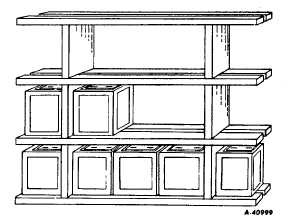|
| |
TRUCK SERVICE MANUAL
TM 5-4210-230-14&P-1
5.
Start engine and check operation of vehicle's charging
system. If necessary, adjust or repair charging system
to obtain correct charging output.
6.
Install battery cover (where used).
STORAGE INSTRUCTIONS
Always store batteries in an upright position. Never allow
batteries to be laid on their sides as electrolyte may escape
through the vent holes.
Never stack batteries on top of one another. Simple battery
storage racks can be made from loose, flat boards supported
by the batteries themselves, as shown in Figure 15.
Fig. 15 Battery Storage Rack
Batteries will slowly discharge while standing and will
discharge much faster when warm than when cold. On wet
type conventional batteries, selfdischarge can amount to
about an average of .001 specific gravity per day over a 30
day period. To minimize self-discharge, store batteries in as
cool a place as possible, away from heat ducts in winter and
shielded from direct sunlight in summer.
Ideal storage conditions would be in a clean dry area where
temperature would be stable and as cool as possible between
0°C
(32°F)
and
26°C
(80°F).
Storage
in
ambient
temperatures above 26°C (80°F) is not recommended as this
increases the rate of self-discharge. Temperatures below 0°C
(32°F) should be avoided to prevent freezing should a battery
become discharged.
Wet batteries in storage should be checked for state of charge
every 30 days and charged when-
ever they fall to 1.225 specific gravity. A charge rate of one
ampere for each positive plate in one cell should be used to
recharge the battery.
IMPORTANT
Batteries of vehicles standing in storage should be
considered as batteries in storage. Vehicles in
inventory should be maintained regularly to keep
their batteries clean and dry, properly filled with water
and, most important, fully charged.
Because of their chemical composition, maintenance free
batteries self-discharge at a slower rate than conventional
batteries. When stored as recommended, a shelf life of up to
twelve months or more depending upon storage temperatures,
is possible before charging is required.
Maintain proper battery stock rotation. The first batteries
placed in storage should be the first ones taken out. (Be sure
to check date codes on the batteries and the cartons.)
If a battery has been in storage for some time, it should be
charged before being installed in a vehicle.
ACTIVATING DRY CHARGED BATTERIES
Dry charged batteries provided for replacement installation
must be "activated" before they can be used. Following the
instructions outlined below will assure proper activation
regardless of temperature and conditions of storage.
IMPORTANT
Always refer to and follow manufacturer's activation
instructions furnished with battery.
1.
Fill each cell of the battery to the top of the separators
with the correct battery-grade electrolyte as specified
by the manufacturer's instructions. Using higher or
lower specific gravity electrolyte than recommended
can impair battery performance. Originally filling each
cell to the top of the separators permits expansion of
the electrolyte as battery is boost charged.
2.
Gently rock battery. This will help to force out trapped
air and to saturate the plates with electrolyte.
CTS-2771 Page 17
PRINTED IN UNITED STATES OF AMERICA
|

